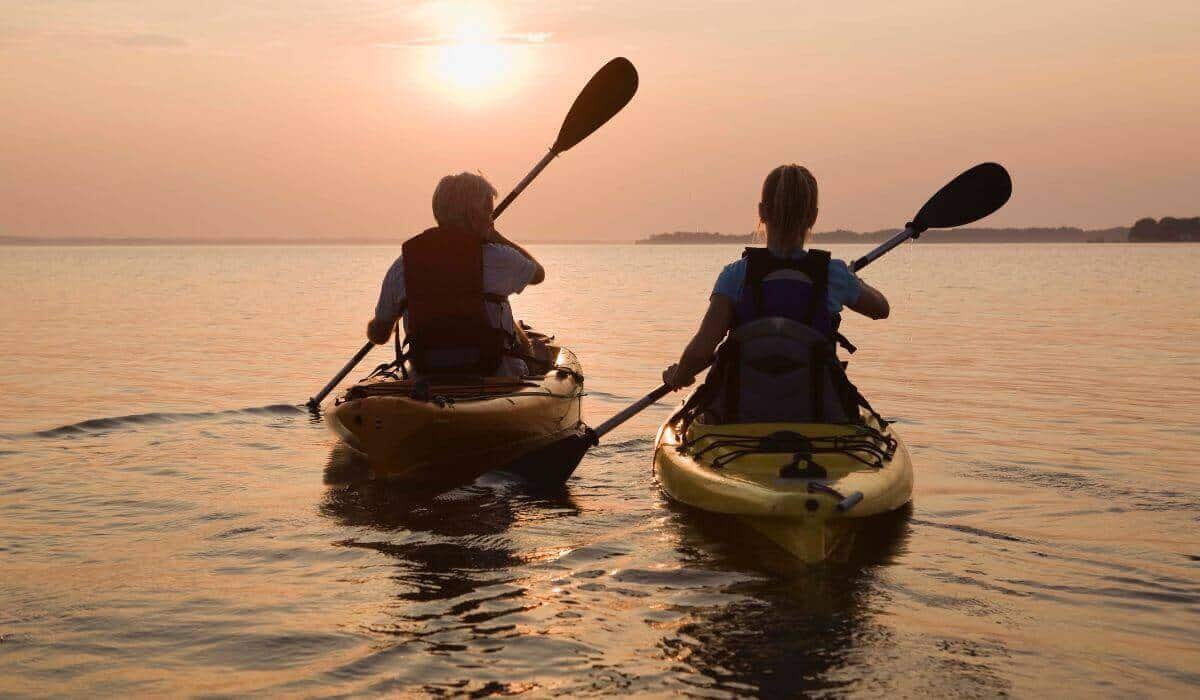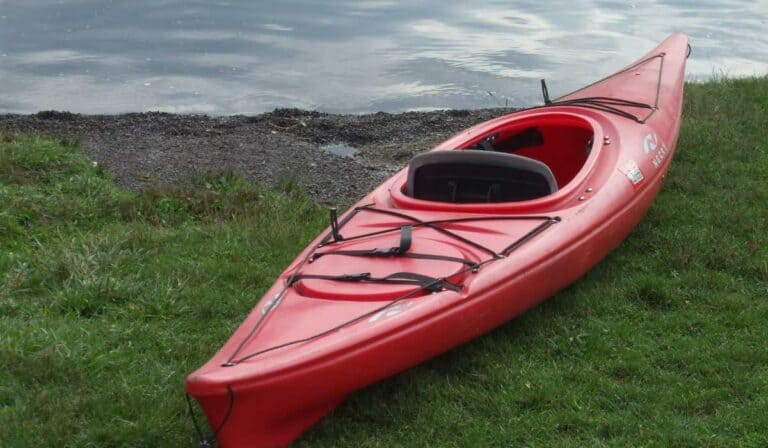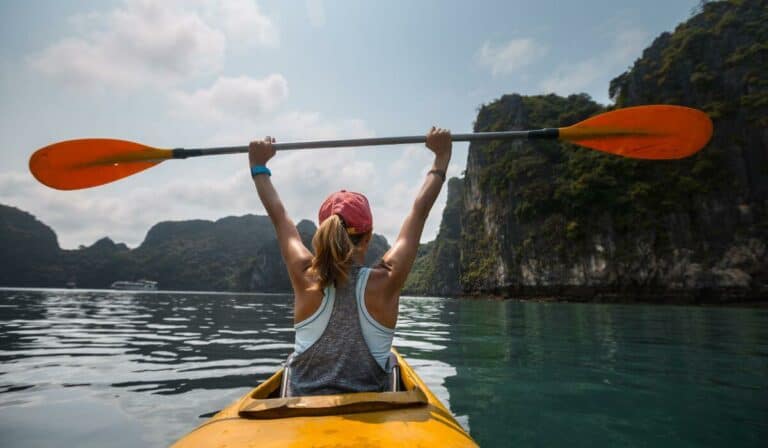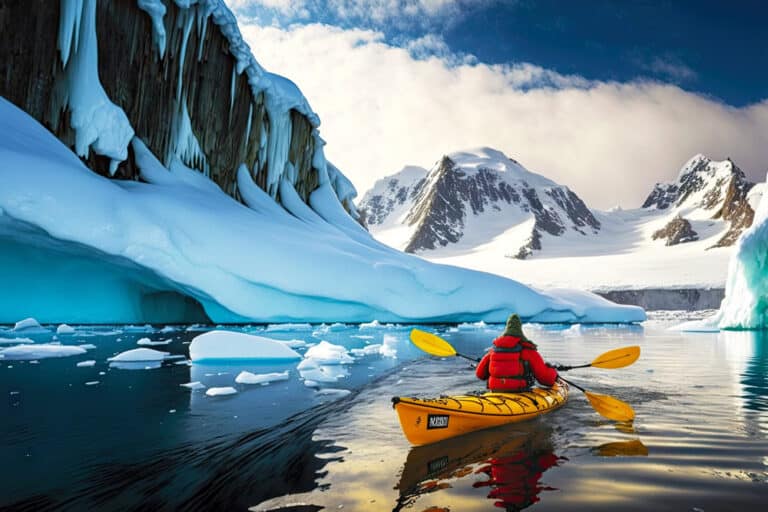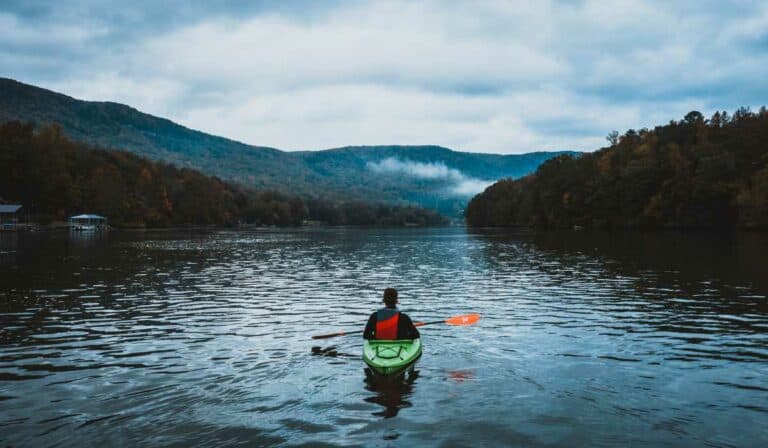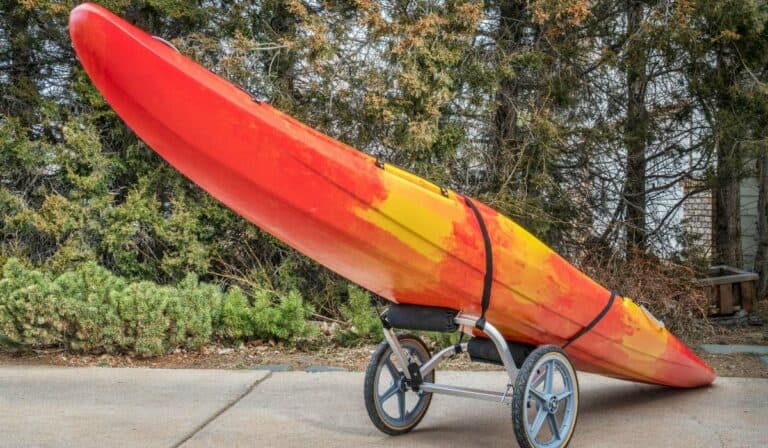7 Essential Kayaking Safety Tips
As a seasoned kayaker, I understand the importance of safety while out on the water. In this blog post, you will learn essential Kayaking Safety Tips to ensure that your paddling experience is both enjoyable and safe.
We’ll cover everything from choosing the right personal flotation device to understanding the hazards of off-shore winds. Whether you prefer sit-inside or sit-on-top kayaks, quiet lakes, or riverways, this post is packed with valuable information that every kayaker should know before embarking on their next adventure. So let’s dive into these crucial Kayaking Safety Tips together and make sure we stay safe while enjoying our time on the water!
Table of Contents
Essential Kayaking Safety Gear
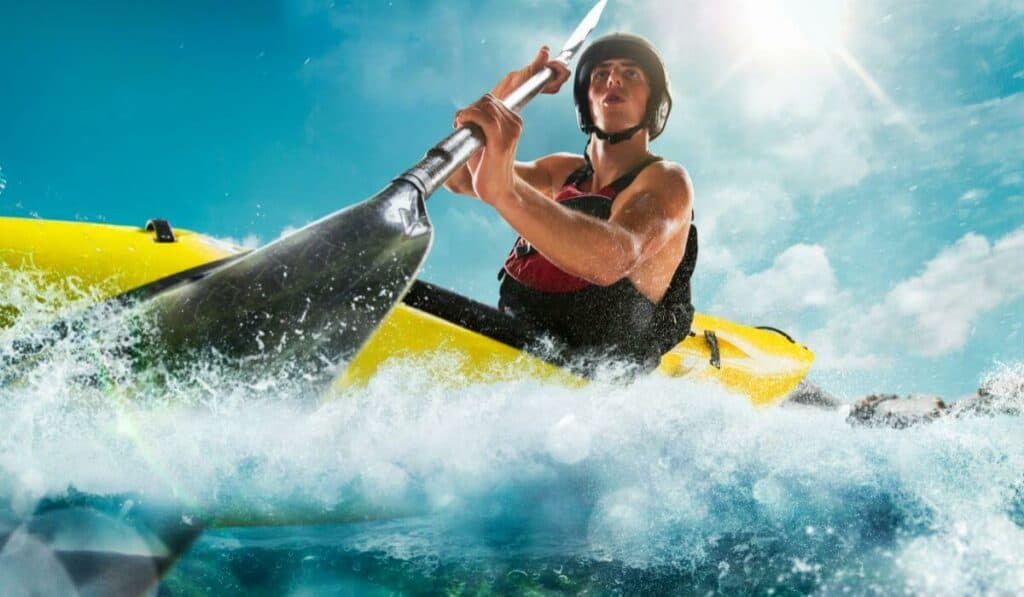
Kayaking is a thrilling pastime that can be experienced by folks of all ages and capabilities. Ensuring you have the appropriate safety equipment is an absolute necessity before engaging in kayaking.
1. Buoyancy Aid or Life Jacket:
Wearing a well-fitting buoyancy aid or life jacket is non-negotiable for all kayakers regardless of their experience level. A correctly fitting buoyancy aid or life jacket is essential for any kayaker to ensure that they remain afloat if they were to fall from their vessel.
2. Appropriate Clothing:
Kayaking involves exposure to both sun and cold temperatures depending on where you are paddling, so make sure you dress appropriately for the conditions. Quick-dry materials like neoprene will help protect against hypothermia in colder waters while UV protection clothing can help prevent sunburns in warmer climates. Avoid cotton fabrics as they tend to hold moisture which could cause discomfort when wet and increase the risk of hypothermia if exposed to cold weather conditions.
Other Necessary Equipment:
A whistle is a must-have item as it can be used to signal distress if needed, plus a paddle leash so that you don’t lose your paddle in case it slips out of your hands while paddling. Also Kayak Lights for Long Distance Paddling.
Finally, bring along a waterproof bag for storing valuables such as car keys, phones, or wallets – this way everything stays dry even if there’s some splashing.
Having the necessary items with you at all times can make a kayaking trip much safer, regardless of your level of experience. Having the right gear can help protect against hypothermia in colder waters and sunburns in warmer climates, plus a whistle for signaling distress and a paddle leash to keep your paddle from getting lost. A waterproof pouch is essential to ensure that items like car keys, cell phones, and wallets stay dry in the event of any water contact.
Ensuring you have the requisite kayaking safety equipment is an absolute must for any person who paddles, so make certain to be equipped with all necessary items before setting off on your next excursion. With the right safety gear in hand, you can now move on to honing your paddle skills.
The Idea: Don’t hit the water without a well-fitting buoyancy aid or life jacket, and dress appropriately for sun exposure or cold temperatures. Make sure to bring along other safety essentials such as a whistle, paddle leash, and waterproof bag – these will help keep you safe on your kayaking trip like a charm.
Basic Paddle Techniques
Basic paddle techniques are essential for kayakers of all levels. Regardless of your level, it’s essential to comprehend the fundamentals and habitually rehearse them for secure boating.
The forward stroke is employed to drive the kayak ahead and can be accomplished with either one-handed or two-handed oars. When using a one-handed paddle, hold it at shoulder level and place the blade perpendicular to the boat before pushing away from you with your arm straightened out. With two-handed paddles, grip both handles firmly while keeping your elbows close together as you pull back toward yourself.
Sweep strokes are used when turning or maneuvering around obstacles in tight spaces such as rivers or streams. To do this correctly, hold your paddle parallel to the boat then sweep it outward in an arc motion while keeping it low near the surface of the water. This will help push against currents and create enough torque for steering control without overcorrecting too quickly which could cause tipping over if not done properly.
Draw strokes involve pulling toward yourself instead of pushing away like with forward strokes. This technique is helpful when navigating through narrow channels that require precise movements since draw strokes provide more control than sweeping motions would offer in these situations.
Grip both sides of your paddle tightly then pull inward towards yourself slowly until the desired direction has been achieved – don’t forget to keep those elbows close.
For advanced-level professionals with an IQ of 150, bracing is a key skill to master when kayaking to maintain balance during choppy waves or strong winds. To successfully brace, one must lean slightly into the side that needs support while also raising one knee onto its corresponding thigh to shift more weight towards that area and avoid capsizing due to unexpected gusts or swells. With practice, you can stay afloat like a pro.
Overall, mastering basic paddle techniques can make all the difference between having a fun day out on calm waters versus ending up stranded somewhere far from shore after being swept away by unpredictable currents due to a lack of knowledge about proper navigation methods. So take some time before hitting open waters; practice makes perfect.
Learning basic paddle techniques is essential for any kayaker, and understanding weather conditions can help you stay safe while out on the water. Gaining proficiency in kayak handling techniques can provide the assurance you need to have a great time on the lake.
The Idea: To ensure a safe and rewarding aquatic experience, honing fundamental paddle techniques is imperative for any experienced paddler. With practice comes proficiency, so be sure to brush up your skills before hitting open waters or you might end up in choppy seas.
Understanding Weather Conditions
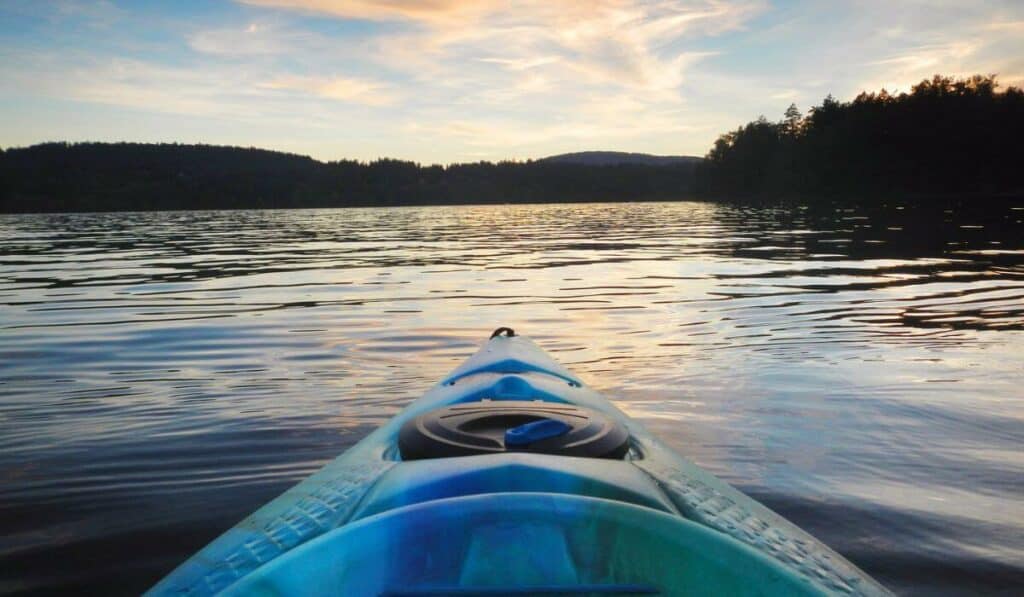
Before any kayaking excursion, it is vital to evaluate the atmospheric and marine circumstances. Wind speed and direction can have a significant impact on your ability to paddle efficiently, while tides and currents can significantly affect navigation. Knowing these factors beforehand will allow you to adjust your route if needed.
Wind speed should be monitored closely as strong winds can make paddling difficult or even dangerous in some cases. Winds of 8-10 knots (9-11 mph) are optimal for kayaking; however, higher velocities necessitate extra safeguards like wearing a life vest or employing a spray skirt. When plotting a course, the wind’s direction is essential to take into account; a headwind can impede progress whereas tailwinds may aid in hastening arrival.
Launching upstream during ebb tide can provide a leg up on reaching downstream destinations, so consider tidal flows when selecting launch sites. When paddling against flood tide (incoming current), the extra oomph of an outgoing current may be just what you need to get where you’re going faster and with less effort.
Wind speed and direction should also be taken into account; headwinds will slow your progress while tailwinds could help make for smoother sailing. For optimal efficiency, aim for 8-10 knots (9-11 mph) but don’t forget to take additional safety precautions if winds exceed this range.
For advanced-level boaters, assessing sea conditions is paramount before hitting the water. Paying attention to wave height and frequency as well as the swell size and periodicity will ensure appropriate safety measures are taken depending on what type of craft you’re using for your aquatic activities.
When waves exceed 3 feet high, extra caution should be taken due to their potential for capsizing smaller crafts like kayaks – unless they’re equipped with proper flotation devices such as PFDs, wet suits, and helmets (depending on region-specific regulations). Swells over 5 feet long combined with 10-second intervals typically signify rough waters that could spell trouble; conversely swells under 2 feet accompanied by 15-second intervals indicate relatively placid seas ideal for novice boat riders just getting their start in marine sportsmanship adventures.
Overall, understanding weather conditions before setting out on any kayak trip is essential for staying safe throughout the journey. By monitoring wind speed and direction, tidal flows, and sea states ahead of time – along with packing necessary safety gear – you will have everything needed for an enjoyable day out exploring nature’s wonders.
Before you embark on your kayaking adventure, be sure to consider the meteorological elements and their potential effects. Choosing safe locations is also essential when you are looking for the perfect spot to paddle; stick to shallow waters if you’re new to kayaking and familiarize yourself with the area first.
The Idea: Before hitting the water, advanced-level kayakers need to assess weather and sea conditions to stay safe. Wind speed and direction should be monitored closely while tidal flows and wave height frequency need to be taken into account when selecting launch sites – that way you can sail safely through any aquatic adventure.
Choosing Safe Locations
When selecting a kayaking spot, it is essential to consider your proficiency and the environment of the area; particularly for novices who should prioritize sheltered areas with minimal wind and wave action. Beginners should always stick with shallow waters that are protected from wind and waves. This will help you gain confidence in your abilities before taking on more challenging locations like sea kayaking courses or open water. Additionally, try to avoid areas where motorboats frequent since they create large waves which could easily capsize even experienced paddlers.
For those just starting, seek bodies of water with low currents and no rapids to gain familiarity with paddle techniques without having to contend with strong currents or winds. You’ll want an area that is relatively calm so you can get comfortable with basic paddle techniques without having to worry about being swept away by strong currents or fighting against winds and tides. Look for spots where there are plenty of other boats around as well; this way if something goes wrong you know someone is close enough to come to lend a hand.
Additionally, consider how far away from shore you plan on going when selecting a spot – especially if you’re still learning the ropes. It’s best practice not to venture too far out until you feel confident in your skillset as swimming back isn’t always possible depending on the distance between yourself and the land. Even seasoned paddlers should stay within eyesight of shore at all times just in case an emergency arises while they’re out exploring.
Finally, make sure to check weather conditions before heading out on any adventure – regardless of whether it’s kayaking or otherwise. High winds can quickly turn what were once peaceful waters into dangerous rapids which can be difficult, if not impossible, for Kayak beginners or even experienced boaters alike to navigate safely through them without proper preparation beforehand. If inclement weather is forecasted during your planned outing time then postpone until another day when conditions improve; safety should always come first.
When choosing a location to kayak, it is important to take into account the depth of the water and any potential hazards. Once you’ve settled on a secure area for your kayaking journey, it’s essential to consider the effects of drinking alcohol and sun exposure on your well-being.
The Idea: Picking a suitable area to kayak that is appropriate for your skill level and being mindful of weather changes is essential when engaging in this activity. Beginners should stay close to shore in calm waters while experienced paddlers must keep an eye on the horizon at all times – safety first.
Alcohol Consumption & Sun Exposure

When kayaking, it is wise to be aware of the potential risks posed by drinking alcohol and being exposed to too much sun. Alcohol consumption can impair judgment, leading to dangerous situations on the water. It is best practice to avoid drinking altogether when planning a kayak trip. Additionally, proper protection from the sun’s harmful rays is essential for safety while out on the water.
One should take into account not just physical health when entering a kayak or other vessel, but also the effects of alcohol on mental faculties and judgment. Just like driving a car after having one too many drinks, operating a boat or kayak under the influence of alcohol increases the risk of accidents caused by impaired judgment due to intoxication – something no experienced boater would ever do.
Sun exposure can be hazardous if you’re not dressed and shielded with sunscreen when out in the sun. To protect yourself from UV radiation, wear light-colored clothes made from tightly woven fabrics such as cotton or synthetic blends which provide more coverage than loose-fitting garments like tank tops and shorts alone will offer. Also, make sure you use an SPF 30+ broad spectrum sunscreen at least 20 minutes before going outside so it has time to soak in before coming into contact with sunlight – reapply every two hours if needed.
Finally, don’t forget about hats. Wearing wide-brimmed hats helps keep direct sunlight off your face and neck while providing extra protection against UVA/UVB rays during long days spent outdoors paddling around lakes or riverside locations where shade may be limited. The same goes for sunglasses: polarized lenses are great for reducing glare which makes seeing obstacles ahead easier than ever before.
So remember:
always stay safe by avoiding alcoholic beverages before heading out onto open waters in your kayak and wear protective clothing along with SPF 30+ broad spectrum sunscreen plus wide-brimmed hats & polarized sunglasses when necessary. These simple steps will help ensure enjoyable experiences without compromising safety standards set forth by experienced outdoor enthusiasts everywhere.
Staying cognizant of the potential harms from drinking and being in the sun while kayaking is critical to safeguarding your health. To ensure your safety on the water, it is essential that you create a float plan and have emergency contacts in place before heading out for your adventure.
The Idea: For a safe and enjoyable kayaking experience, it’s important to avoid consuming alcohol beforehand and protect oneself from the sun by wearing appropriate clothing, sunscreen with SPF 30+, hats, and polarized sunglasses. Follow these simple steps for an optimal outdoor adventure.
Float Plan & Emergency Contacts
It’s essential to have a float plan and emergency contacts when you’re out on the water. Whether you’re kayaking in quiet lakes or paddling along wild riverways, having a safety-conscious attitude is key. Before embarking, ensure you are outfitted with the proper safety equipment such as a properly fitting PFD for extended wear. Additionally, know your paddling location – what type of environment are you entering? Are there any potential hazards like off-shore winds or cold water temperatures? It is critical to drink plenty of fluids during the journey and check the weather before setting off.
Once these preparations are complete, it’s time to create a float plan with at least one responsible individual who knows your route and expected return time – this could be anyone from family members to friends or even local park rangers. Place your name, phone number, and emergency contact info on both yourself and your kayak so rescuers can locate you quickly if needed. It is also invaluable to learn exposed water rescue skills which will help during emergencies while out on the water; most outdoor recreation centers offer courses specifically tailored for sea kayaking trips.
Finally, remember that no matter how experienced a paddler you are, always follow basic safety rules like wearing proper clothing for protection against cold conditions and carrying extra supplies just in case something unexpected happens during your journey. So whether it’s a leisurely paddle around the lake or an adventurous expedition downriver, staying safe should always come first.
It is important to always have a float plan and emergency contacts with you when kayaking. Practice re-entering your kayak from the water before needing it in an emergency, staying close enough to shore that swimming back is possible.
The Idea: It’s important to stay safe when kayaking, so always have a float plan with emergency contacts in place and wear appropriate clothing for protection against cold conditions. Additionally, take exposed water rescue courses and be sure you know your route before setting off – safety should come first.
Re-entering Your Kayak From The Water
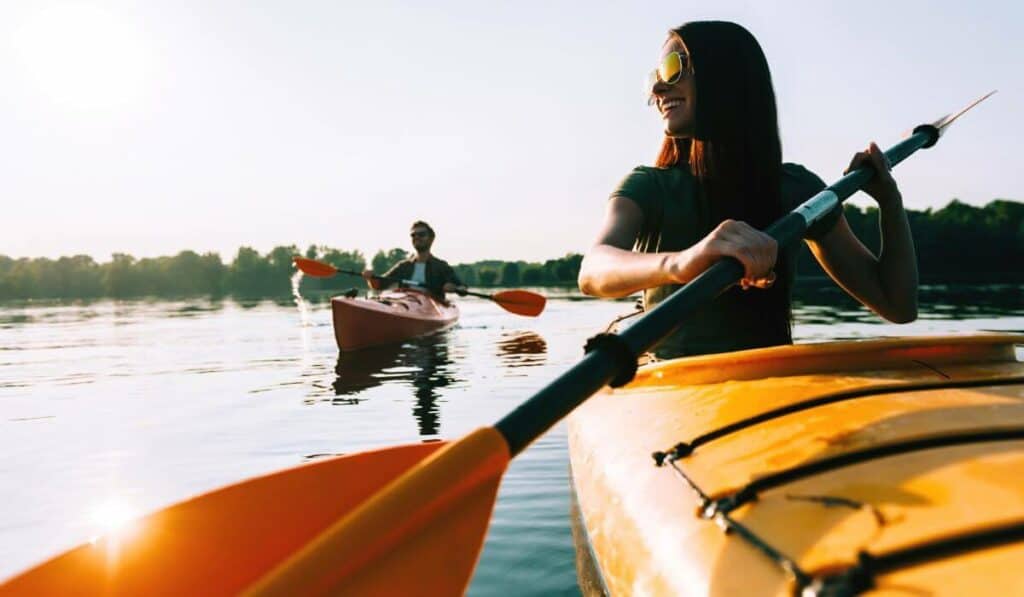
For experienced kayakers, re-boarding from the water may be a straightforward task; however, for those new to paddling, it can seem intimidating. It’s essential to hone this ability before needing it in a genuine context. Attempting the maneuver in shallow water or a place where there is no risk of being taken away by powerful currents can be beneficial when practicing this technique.
Approaching the side of your kayak at an angle, firmly grab ahold of both sides of the cockpit rim with one hand on each. Taking a deep breath and using only your arms for leverage, heave yourself up while pushing off from below with your feet until you have managed to get one leg inside and swing over into position to settle snugly within the seating area. By honing this skill before ever needing it out on open water, you will be able to confidently re-enter your kayak without fear should capsizing occur. To ensure safety is maintained during practice sessions or real-life scenarios, stay close enough to shore that swimming back is always possible.
If unable to confidently re-enter kayaks from the water stay close enough to shore that swimming back is possible – but make sure there aren’t any obstacles like rocks or other boats blocking access before doing so. If possible, have someone nearby who can help if needed as they may be able to provide additional support when attempting reentry – just make sure they know what they’re doing too.
Finally, always wear a personal flotation device (PFD) which will keep you afloat should capsizing occur unexpectedly during turbulent conditions or bad weather. Having PFDs readily available will also ensure that everyone onboard has adequate buoyancy should emergencies arise while out on open waters such as lakes and oceans.
The Idea: Practice makes perfect when it comes to re-entering your kayak from the water and having a PFD handy will help ensure safety should an emergency arise. Always stay close enough to shore that swimming back is possible if unable to confidently enter your vessel, but make sure there are no obstacles blocking access first.
FAQs about Kayaking Safety Tips
What are the safety requirements of a kayak?
When kayaking, it is important to ensure that you have the proper safety equipment and clothing. Wear a life jacket at all times, even if you are an experienced paddler. Ensure that your paddle is functioning optimally and securely attached to the kayak.
Be aware of changing weather conditions and know how to handle them safely. Check for obstacles like rocks or shallow areas before entering any body of water, as well as any current or tides that may be present in larger bodies of water.
Finally, never go out alone; always bring someone with you who can help if something goes wrong on the water.
What are the three golden rules of kayaking?
1. Wearing a well-fitted, authorized PFD is an absolute necessity when kayaking, no matter your proficiency or prior experience.
2. Check the weather conditions before heading out: Make sure you are aware of any weather changes that may occur while on the water so you can adjust accordingly and stay safe during your trip.
3. Pay attention to other boats, swimmers, surfers, etc., as well as rocks and debris to avoid collisions or dangerous situations for yourself and others near you.
What are some safety tips for canoeing and kayaking?
Always wear a life jacket when canoeing or kayaking. Before heading out, review the forecast and be mindful of any shifts in climate while on the lake. Ensure you are familiar with your boat, its equipment, and how to use it safely.
Know your limits and paddle within them; avoid paddling alone or at night unless experienced. Make sure to have appropriate safety gear such as an emergency whistle, first aid kit, spare clothing, etc., ready for use if needed. Be aware of other vessels around you and take extra caution near dams or rapids where there may be strong currents present.
What could go wrong with kayaking?
For optimal safety, kayakers should don a life jacket and consider the weather before launching their craft. Kayakers should always wear a life jacket, and check weather conditions before heading out on the water.
Poorly maintained equipment or inexperience can also lead to problems such as capsizing, getting lost in unfamiliar waters, or being caught in strong currents. Kayakers should be cognizant of their abilities and not exceed them when out on the water, to avoid potential danger.
Conclusion
Kayaking is an incredibly rewarding activity that can be enjoyed safely with the right preparation and Kayaking Safety Tips. Before taking to the water, ensure that you are adequately prepared with appropriate gear and have reviewed all necessary safety protocols.
Make sure to choose the right gear for your journey, plan before setting out on the water, practice basic safety techniques while in transit, and review any post-trip protocols when returning from your adventure. By following these simple guidelines, you will maximize both fun and safety during every kayak excursion.
Join us on SunWaterDirt.com to learn the best kayaking safety tips and techniques so you can confidently explore rivers, lakes, and oceans with peace of mind! Discover our comprehensive guides for paddlers of all skill levels today.

